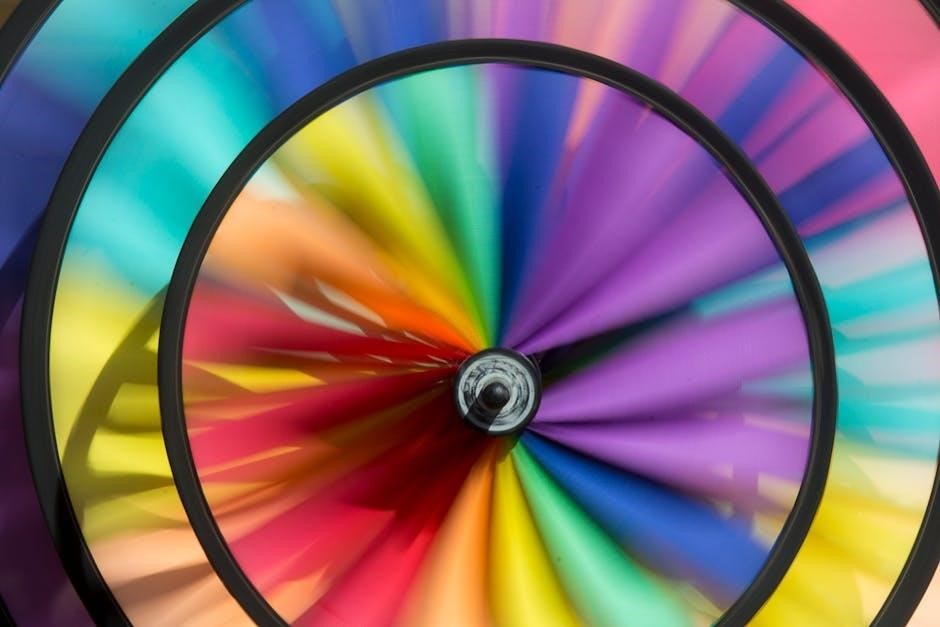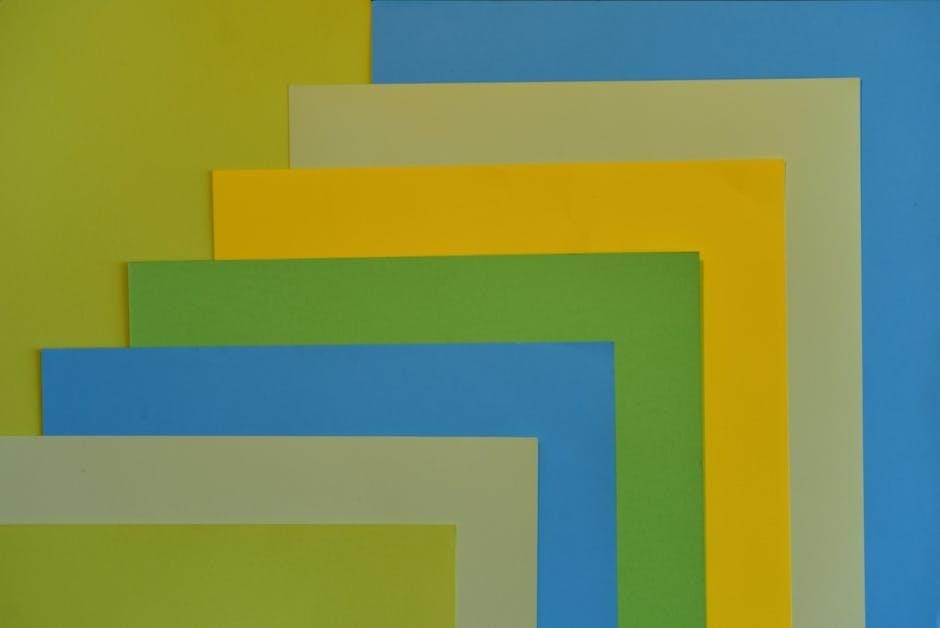colour wheel pdf
A colour wheel PDF is a versatile tool for understanding colour theory, offering customizable templates for artists, designers, and educators. Download and print free versions online, perfect for graphic design, art projects, and interior decorating. Lamination enhances durability for frequent use.
What is a Colour Wheel?
A colour wheel is a circular diagram that organizes colours systematically, showing how they relate to one another. It is a fundamental tool in colour theory, helping to identify primary, secondary, and tertiary colours. The wheel demonstrates complementary and analogous colour schemes, as well as warm and cool tones. Available as a downloadable PDF, it serves as a handy reference for artists, designers, and educators. Customizable templates allow users to experiment with colour combinations, making it ideal for graphic design, art projects, and interior decorating. By understanding the colour wheel, one can create harmonious colour schemes and enhance visual appeal in various creative fields. It is both educational and practical, offering insights into colour mixing and balance.
Importance of Colour Theory in Design
Colour theory is essential for creating visually appealing and effective designs. It provides a framework for understanding how colours interact, enabling the creation of harmonious colour schemes. A colour wheel PDF is a key tool, offering insights into primary, secondary, and tertiary colours, as well as complementary and analogous palettes. Designers use this knowledge to evoke emotions, convey messages, and guide viewer attention. Whether for graphic design, art, or interior decorating, colour theory enhances creativity and ensures professional results. By mastering colour principles, professionals can craft designs that resonate with their audience, making colour theory a cornerstone of artistic and design practices.
Structure of the Colour Wheel
The colour wheel is a circular arrangement of hues showcasing primary colours and their gradual transitions. It visually organizes colour relationships and harmonies, enhancing creativity.
Primary, Secondary, and Tertiary Colours

The colour wheel is built on three core categories: primary, secondary, and tertiary colours. Primary colours—red, blue, and yellow—are the base hues that cannot be created by mixing others. Secondary colours, such as green (blue + yellow), purple (blue + red), and orange (red + yellow), are formed by combining two primary colours. Tertiary colours emerge when a primary colour is mixed with a secondary colour, resulting in shades like yellow-green, blue-green, red-orange, and others. This hierarchical structure forms the foundation of colour theory, enabling artists and designers to create harmonious colour schemes. Understanding these categories is essential for effective colour mixing and design.
Complementary and Analogous Colours
Complementary colours are pairs of hues directly opposite each other on the colour wheel, such as blue and orange or red and green. These combinations create high contrast and visual intensity, making them ideal for designs requiring emphasis. Analogous colours, however, are adjacent to each other, like blue, green, and yellow. They produce smooth transitions and harmony, often used in cohesive designs. Understanding these relationships is crucial for creating visually appealing colour schemes. Complementary colours can enhance contrast, while analogous colours promote unity. Artists and designers rely on these principles to evoke specific moods and guide viewer attention effectively in their work.
Warm and Cool Colours
Warm colours, such as red, orange, and yellow, are located on one side of the colour wheel and evoke warmth and energy. They often symbolize excitement, passion, and urgency, making them ideal for stimulating environments. Cool colours, including blue, green, and purple, are on the opposite side and convey calmness, serenity, and professionalism. These hues are perfect for creating soothing atmospheres and balancing designs. The distinction between warm and cool colours helps artists and designers create contrast and harmony in their work. Understanding this duality is essential for effectively using the colour wheel in art, design, and even interior decorating to achieve desired emotional responses and visual balance.

Practical Applications of the Colour Wheel
The colour wheel is a versatile tool for graphic design, branding, and interior decorating. It helps create harmonious colour schemes, enhances visual appeal, and ensures professional results.

Using the Colour Wheel for Graphic Design
The colour wheel is an essential tool for graphic designers, helping to create visually appealing and harmonious designs. By identifying complementary and analogous colours, designers can craft professional-looking colour schemes. It aids in selecting contrasting hues for text and backgrounds, ensuring readability and visual balance. The colour wheel also simplifies the process of creating brand-consistent designs by maintaining a cohesive colour palette. For digital projects, it helps in selecting RGB colours that translate well across screens. Print designers benefit from CMYK colour matching, ensuring accurate results. Laminating a colour wheel PDF provides a durable reference for quick inspiration and decision-making.
Colour Schemes in Art and Craft Projects
The colour wheel is a vital resource for creating harmonious colour schemes in art and craft projects. It helps artists and crafters identify complementary and analogous colours, ensuring visually appealing combinations. By studying the wheel, creators can experiment with contrasting hues for dynamic effects or muted tones for subtle designs. For painting, sewing, or pottery, it guides the selection of palettes that evoke specific moods. Print a colour wheel PDF to have a handy reference for mixing colours accurately. This tool also aids in understanding how to create gradients and ombre effects. Whether for canvas art or DIY crafts, the colour wheel enhances creativity and precision in colour selection.
Interior Decorating with Colour Harmony
The colour wheel is an essential tool for achieving colour harmony in interior decorating. It helps designers select complementary, analogous, or triadic colour schemes that create a cohesive and visually appealing space. By understanding how colours relate on the wheel, decorators can choose wall colours, furniture, and accents that work together seamlessly. For example, complementary colours can add vibrancy, while analogous colours create a calming atmosphere. The 60-30-10 rule, a fundamental principle in interior design, can also be applied using the colour wheel. A printable colour wheel PDF is a practical resource for planning and visualizing colour schemes before making final decisions. This ensures a harmonious and functional living or working environment.
Downloading and Printing a Colour Wheel PDF
A colour wheel PDF is easily downloadable from various online sources, offering a practical tool for colour planning. Print it on sturdy paper or cardstock for durability.
Free Colour Wheel Templates Available Online

Free colour wheel templates are widely available online, offering a convenient way to access and print customizable colour wheels. These templates are often downloadable in PDF format, making them easy to share and use. Many websites provide high-quality, printable colour wheels designed for various purposes, from education to professional design. Whether you’re an artist, educator, or designer, you can find templates tailored to your needs. These tools often include pre-designed colour schemes and mixing guides, saving you time and effort. Simply search for “free colour wheel PDF” to explore a variety of options. Customize and print them to suit your projects or teaching materials.
Customizing Your Colour Wheel Chart
Customizing your colour wheel chart allows you to tailor it to your specific needs, enhancing its utility for your projects. Many downloadable colour wheel PDFs come with editable features, enabling you to adjust hues, add labels, or highlight specific colour combinations. Using design software like Adobe Illustrator or Photoshop, you can modify the layout, add custom colour swatches, or incorporate personal notes. Online tools and colour picker apps also let you create digital versions with precise RGB and HEX codes. By personalizing your colour wheel, you can focus on the colours relevant to your work, making it a more effective tool for design, art, or educational purposes; This ensures your colour wheel remains a practical and adaptable resource.
Laminating Your Colour Wheel for Durability
Laminating your colour wheel is an excellent way to protect it from wear and tear, ensuring long-lasting use. By sealing the PDF printout in a laminating pouch, you prevent damage from spills, smudges, or tears. This is particularly useful for educational settings or frequent use in design projects. To laminate, place the colour wheel in a thermal laminator pouch and run it through a laminator; For added protection, use a high-quality pouch with UV resistance to prevent colour fading. Once laminated, the colour wheel becomes durable and easy to clean, making it a practical tool for both professional and educational purposes. This simple step extends its lifespan and maintains its vibrant colours.
Colour Wheel for Artists and Designers
A colour wheel PDF is an essential tool for artists and designers, providing a quick reference for colour mixing, harmony, and palette creation, enhancing creativity and precision.

Understanding Colour Mixing
A colour wheel PDF is a vital resource for understanding colour mixing, as it visually represents how colours interact and blend. By studying the wheel, artists and designers can identify primary colours (red, blue, yellow) and see how they mix to create secondary colours (orange, green, violet). Tertiary colours, formed by mixing primary and secondary hues, further expand the palette. The colour wheel also illustrates complementary colours, which are opposite each other and create vibrant contrasts when used together. This tool helps predict how colours will behave when mixed, ensuring harmonious results in art, design, and even interior spaces. It simplifies the complexity of colour theory, making it accessible for both beginners and professionals.
Creating Custom Colour Combinations
A colour wheel PDF is an essential tool for creating custom colour combinations that evoke specific moods or themes. By analyzing the wheel, designers can identify complementary, analogous, and triadic colour schemes. Complementary colours, placed opposite each other, create bold contrasts, while analogous colours, situated side by side, produce smooth transitions. Triadic colours, forming a triangle on the wheel, offer vibrant and balanced combinations. Experimenting with these schemes allows artists to craft unique palettes tailored to their projects. Additionally, the PDF format enables easy sharing and printing, making it a practical resource for brainstorming and planning. This approach ensures colour harmony and visual appeal in graphic design, branding, and art projects.
HEX, RGB, and HSL Colour Codes
Understanding HEX, RGB, and HSL colour codes is crucial for digital design, and a colour wheel PDF can help bridge the gap between traditional colour theory and modern coding systems. HEX codes, used in web design, represent colours using six characters (e.g., #FF0000 for red). RGB (Red, Green, Blue) codes define colours for digital screens, while HSL (Hue, Saturation, Lightness) codes prioritize colour perception. These systems enable precise colour reproduction across devices. A colour wheel PDF can assist in identifying corresponding HEX, RGB, and HSL values for colours, ensuring consistency in digital projects. This integration of traditional and digital tools empowers designers and artists to work seamlessly between analogue and digital mediums, enhancing creativity and precision.

Educational Use of the Colour Wheel
A colour wheel PDF is an essential educational tool for teaching colour theory, enabling students to explore primary, secondary, and tertiary colours through visual learning effectively.
Teaching Colour Theory to Students
A colour wheel PDF is an invaluable resource for educators teaching colour theory to students. It provides a visual representation of colour relationships, making complex concepts like primary, secondary, and tertiary colours easy to understand. Teachers can use the PDF to demonstrate how colours mix and interact, fostering a deeper appreciation for colour harmony. Practical exercises, such as identifying complementary and analogous colours, can be conducted using the PDF, ensuring students grasp fundamental principles. Additionally, the PDF serves as a handy reference for students to explore colour schemes independently, enhancing their creativity and understanding of colour theory in both artistic and design contexts.
Lesson Plans for Colour Wheel Education
Colour wheel PDFs are excellent tools for creating engaging lesson plans that teach colour theory fundamentals. Educators can design activities where students use the PDF to identify primary, secondary, and tertiary colours, exploring how they interact. Lesson plans can include exercises like colour mixing, identifying complementary and analogous colours, and creating harmonious colour schemes. Teachers can also incorporate quizzes or projects that require students to apply their knowledge of the colour wheel. By integrating the PDF into lesson plans, educators can make colour theory accessible and fun, ensuring students develop a strong foundation for future artistic and design endeavors. This approach fosters creativity and understanding in an interactive way.
Vocabulary and Definitions for Beginners
Understanding the colour wheel begins with key terms. Primary colours are red, blue, and yellow, which cannot be created by mixing others. Secondary colours (orange, green, violet) are made by mixing two primaries. Tertiary colours result from mixing primary and secondary colours. Complementary colours are pairs opposite on the wheel, creating contrast. Analogous colours are next to each other, offering harmony. Warm colours (red, orange) evoke warmth, while cool colours (blue, green) suggest calm. Hue refers to pure colour, saturation to its intensity, and shade to its darkness. These terms form the foundation of colour theory, essential for using a colour wheel effectively in design or art.

Advanced Colour Wheel Topics
Exploring advanced techniques like chromatic greys, geometric colour pockets, and abstract schemes, this section delves into sophisticated methods for enhancing colour harmony and creativity.
Chromatic Greys and Colour Balance
Chromatic greys are created by mixing complementary colours, resulting in neutral shades that enhance colour balance. These greys help designers achieve harmony by bridging warm and cool tones, adding depth without overpowering the palette. Understanding chromatic greys is essential for creating visually stable compositions. They can soften bold contrasts and create subtle transitions in art and design projects. By incorporating chromatic greys, artists can balance vibrant hues, ensuring a cohesive and professional look. This technique is particularly useful in graphic design and painting, where colour harmony is critical. Chromatic greys also enable the creation of sophisticated, modern aesthetics, making them a valuable tool for both beginners and experienced designers.

Geometric Colour Pocket Diagrams
Geometric colour pocket diagrams are compact, foldable tools that simplify colour exploration. These diagrams feature a colour wheel arranged in a geometric pattern, allowing artists to easily identify harmonious colour combinations. They are particularly useful for understanding how colours relate spatially and how to create balanced palettes. The foldable design makes them portable, ideal for fieldwork or quick reference. Many colour wheel PDFs include geometric pocket diagrams, enabling users to print and customize them for specific projects. These diagrams are invaluable for designers, painters, and crafters seeking to experiment with colour theory principles on the go. Their practicality and versatility make them a must-have resource for anyone working with colour.
Abstract Colour Schemes
Abstract colour schemes diverge from traditional colour theory, emphasizing emotional expression over strict rules. These schemes often feature unconventional colour combinations that create unique visual effects. A colour wheel PDF can help artists explore abstract palettes by providing a visual reference for experimenting with non-traditional colour relationships. Abstract schemes are ideal for modern designs, art projects, or branding that seeks to evoke specific moods. They encourage creativity and flexibility, allowing designers to break free from predictable colour choices. By using a colour wheel PDF, one can identify unexpected colour harmonies and develop innovative, abstract palettes that add depth and originality to their work. This approach is perfect for those aiming to push boundaries in colour design.

Colour Wheel Tools and Resources
Colour wheel tools and resources include apps, software, and PDF guides, helping designers and artists create harmonious colour schemes. These tools enhance colour selection and theory understanding.
Colour Wheel Apps for Smartphones
Colour wheel apps for smartphones are essential tools for designers and artists, offering portable access to colour theory and scheme creation. Many apps feature interactive colour pickers, allowing users to explore complementary, analogous, and triadic colour combinations. They often include a colour wheel PDF viewer or generator, enabling users to save and share colour schemes. These apps also provide real-time colour mixing simulations and harmony suggestions, making them invaluable for on-the-go projects. Popular apps include Colour Picker, Adobe Color, and Palette Generator, which cater to both professionals and hobbyists. By leveraging these tools, users can enhance their creativity and ensure colour consistency across various design platforms.
Colour Wheel Software for Digital Design
Colour wheel software for digital design is a powerful tool for creating and managing colour schemes. These programs often include advanced features like colour matching, palette generation, and real-time previews. Many software options allow users to import or export colour wheel PDFs, making it easy to share and reference designs. Tools like Adobe Illustrator and Sketch offer built-in colour wheel functionality, while standalone software such as ColorSchemer and ColorSnapper provide specialized colour management. These applications are indispensable for designers, enabling precise control over colour harmony and consistency. By integrating colour wheel PDFs, designers can streamline their workflow and maintain accurate colour references across projects.
Colour Wheel Templates in Illustrator and Word
Colour wheel templates in Illustrator and Word are essential tools for designers and educators. These templates allow users to create custom colour wheels or edit pre-designed ones. In Adobe Illustrator, colour wheel templates often include editable layers and swatches, making it easy to customize hues and arrangements. Microsoft Word templates are simpler but equally useful, offering pre-designed colour wheels that can be printed or shared. Many templates are available online for free, catering to both professional and educational needs. They can be exported as PDFs for easy distribution or printing. These templates are ideal for teaching colour theory, planning designs, or creating visual aids for art and design projects.
A colour wheel PDF is an essential tool for artists, designers, and educators, offering a practical guide to colour theory and harmony. It enhances creativity and learning, proving indispensable in various creative fields.
Why Every Designer and Artist Needs a Colour Wheel
A colour wheel is a fundamental tool for designers and artists, providing a visual guide to colour theory and harmony. It helps create balanced compositions, explores colour relationships, and inspires creativity. By understanding primary, secondary, and tertiary colours, professionals can craft cohesive palettes and experiment with contrasts. The colour wheel also aids in mixing colours accurately, ensuring consistent results across projects. Whether for graphic design, painting, or interior decorating, it streamlines the decision-making process. A colour wheel PDF is portable and accessible, making it an indispensable resource for both beginners and seasoned creators. It enhances productivity and fosters artistic expression, ensuring designs are visually appealing and impactful.
Final Tips for Maximizing Colour Wheel Usage
To maximize the use of a colour wheel, start by printing and laminating your colour wheel PDF for durability and easy reference. Regularly practice colour mixing and palette creation to deepen your understanding of colour theory. Experiment with complementary and analogous colours to enhance your designs. Use the colour wheel to plan cohesive colour schemes for projects, ensuring harmony and balance. For digital work, keep a colour wheel PDF open as a reference while designing. Teach others or review colour theory basics to reinforce your skills. By integrating the colour wheel into your creative process, you’ll streamline decision-making and elevate your artistic and design outcomes consistently.